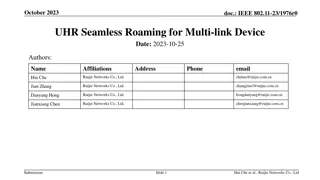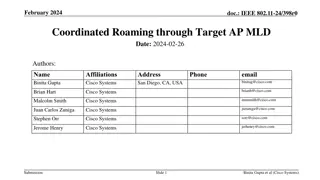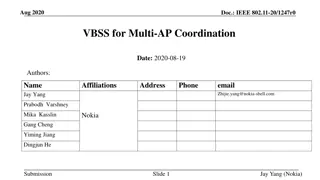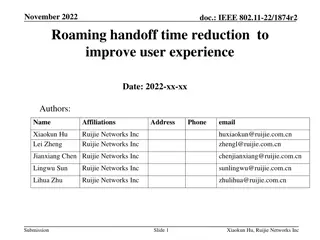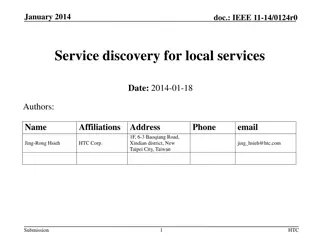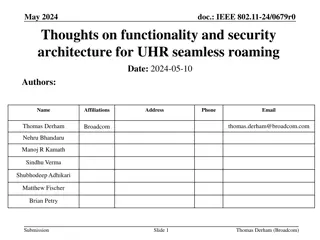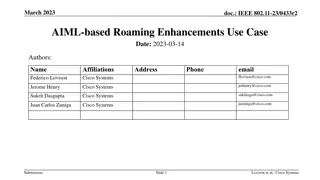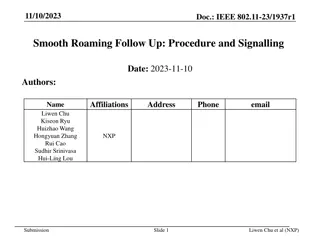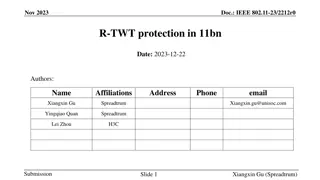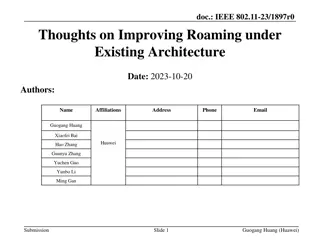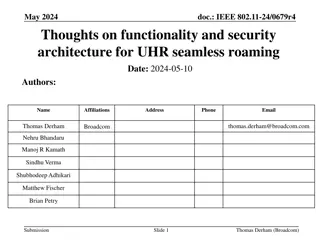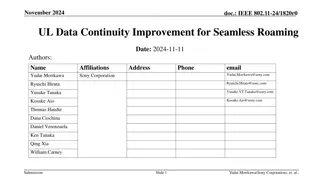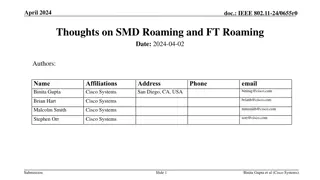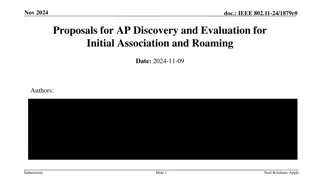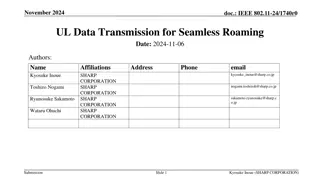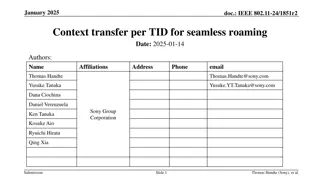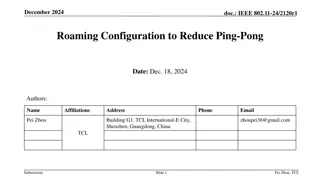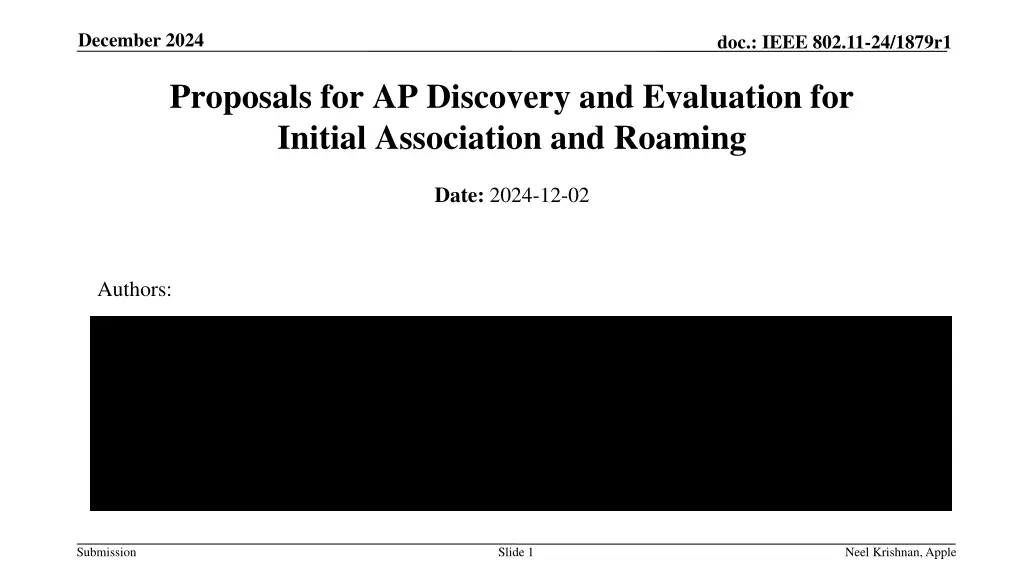
Efficient Proposals for AP Discovery and Evaluation in IEEE 802.11 Networks
Explore proposals to enhance the discovery and evaluation process of neighborhood Access Points (APs) for initial association and roaming in IEEE 802.11 networks. The document discusses limitations of conventional channel scans, existing mechanisms, and objectives to improve communication efficiency between APs and non-AP devices.
Download Presentation

Please find below an Image/Link to download the presentation.
The content on the website is provided AS IS for your information and personal use only. It may not be sold, licensed, or shared on other websites without obtaining consent from the author. If you encounter any issues during the download, it is possible that the publisher has removed the file from their server.
You are allowed to download the files provided on this website for personal or commercial use, subject to the condition that they are used lawfully. All files are the property of their respective owners.
The content on the website is provided AS IS for your information and personal use only. It may not be sold, licensed, or shared on other websites without obtaining consent from the author.
E N D
Presentation Transcript
December 2024 doc.: IEEE 802.11-24/1879r1 Proposals for AP Discovery and Evaluation for Initial Association and Roaming Date: 2024-12-02 Authors: Submission Slide 1 Neel Krishnan, Apple
December 2024 doc.: IEEE 802.11-24/1879r1 Abstract Discuss some considerations and proposals to facilitate effective and expedited discovery of neighborhood APs by a client device (Non-AP STA) for initial association and roaming Submission Slide 2 Neel Krishnan, Apple
December 2024 doc.: IEEE 802.11-24/1879r1 Motivation (1) Discovery and evaluation of neighbor APs / AP MLDs by a Non-AP device is a crucial component in choosing target APs for initial association / roaming Conventionally, a Non-AP device performs autonomous channel scans (active / passive) to discover neighbor APs / AP MLDs; some limitations below: o Channel scans are expensive in time and power consumption; executing channel scans in 2.4/5/6 GHz bands may take a few seconds to complete o Disruption of activities in the home channel of the Non-AP while performing off-channel scans o Full information present in Beacons / Probe Responses is likely not necessary to evaluate the favorability of the discovered APs for association / roaming Hence, it is desirable to devise schemes that enable an efficient discovery of neighbor APs / AP MLDs by a Non- AP while mitigating the overhead entailed by channel scans Key idea An AP (referred to as Reporting AP) provides necessary information about non-co-located neighbor APs / AP MLDs to a Requesting Non-AP device Submission Slide 3 Neel Krishnan, Apple
December 2024 doc.: IEEE 802.11-24/1879r1 Motivation (2) Some mechanisms already exist in baseline spec that somewhat address our goal: o Reduced Neighbor Report (RNR) o Neighbor Report in BSS Transition Management o Multi-link Probe Request / Response However, a few key limitations exist for the existing schemes, as described below: o Information contained is either too little (forcing Non-AP to perform additional channel scans) or too much (resulting in wastage of precious medium airtime) o Reporting AP includes information about only those APs that are co-located with the same AP MLD as the Reporting AP (a behavior that we have observed in the field, even though spec does not impose such a limitation) Our objectives are two-fold: o Motivate AP vendors to communicate information about non-co-located neighboring APs / AP MLDs in response to a Request received from a Requesting Non-AP o Identify a set of attributes that are relevant for initial link setup / roaming and communicate only that set to the Requesting Non-AP to minimize overhead Submission Slide 4 Neel Krishnan, Apple
December 2024 doc.: IEEE 802.11-24/1879r1 Overarching Goal Key takeaway A Non-AP can discover multiple neighbor APs, obtain relevant information about the APs, and create / maintain candidate AP(s) with a single frame exchange with Reporting AP Submission Slide 5 Neel Krishnan, Apple
December 2024 doc.: IEEE 802.11-24/1879r1 Key Considerations The Reporting AP provides the information about neighbor APs / AP MLDs only in response to a request received from a Non-AP o We do not envision this information to be carried always in Beacons, etc., of the Reporting AP, which may otherwise result in gratuitous bloating of such frames The response from the Reporting AP contains only those attributes about neighboring APs / AP MLDs that are necessary for a Non-AP to perform candidate AP selection for initial link setup, roaming, etc. o A client device likely does not need the full information about neighbor APs / AP MLDs (present in Beacons / Probe Response frames) to perform selection of candidate AP(s) for initial association / roaming The content of the response from the Reporting AP should be applicable to both unassociated and associated client devices o The information may be carried in any frame Probe Response, (unsolicited) BTM Request, etc. sent by the Reporting AP o The attributes of interest to a Non-AP for evaluation of neighbor APs / AP MLDs are listed in Slide 12 The response from the Reporting AP may include information about legacy (pre-11bn) neighbor APs / AP MLDs, in addition to 11bn AP MLDs o Providing such information is useful for a Non-AP, especially in the context of initial association Submission Slide 6 Neel Krishnan, Apple
December 2024 doc.: IEEE 802.11-24/1879r1 Enhanced RNR Format (Example) Example of how Reduced Neighbor Report (RNR) can be enhanced to carry relevant information about neighbor APs / AP MLDs Define a new type of RNR information format (TBTT information field type = 2) with the following fields (more details in Slide 14): TBTT Offset (1 byte) BSSID (6 bytes) Short SSID (4 bytes) Neighbor AP Static Attributes (5 bytes) o Co-located o PHY Type o Security Protocol Support Bitmap o IP Address Continuity o Highest NSS o UPR Active o 20 MHz PSD Neighbor AP Dynamic Attributes (3 bytes) o BSS Operating BW o BSS Load + Station Count o Association Disallowed MLD Parameters (1 byte) o AP MLD ID SMD Parameters (1 byte) o SMD ID Submission Slide 7 Neel Krishnan, Apple
December 2024 doc.: IEEE 802.11-24/1879r1 Security Protocol Support of Neighbor APs Goal: Communicate the security protocol (WPA3, WPA2, etc.) supported by each Neighbor / Reported AP o WPA2, WPA3, etc., are terms used by the Wi-Fi Alliance; need to indicate the corresponding AKM Suite Selector(s) for each Reported AP A Client device typically uses security protocol supported by discovered APs / networks to evaluate them for favorability for initial association and roaming o Example order of preference: Enterprise > PSK > Open, WPA3 > WPA2 > WPA > WEP An AP may indicate support for several AKM Suites in RSN element; each AKM Suite is represented using 4 octets (see figure below) Signaling all supported AKM suites (N) entails a high overhead (4*N octets) To rank/evaluate/select candidate APs, knowledge of security protocols / AKM Suites supported by Neighbor AP(s) should suffice Problem Statement: Efficiently communicate the list of AKM Suites supported by each neighbor AP RSNE format Submission Slide 8 Neel Krishnan, Apple
December 2024 doc.: IEEE 802.11-24/1879r1 Proposal: Security Protocol Support Bitmap AKM Suite ID (Table 9-190 in REVme_D7.0) Security Protocol ID Wi-Fi Security Protocol Assign a unique ID (named Security Protocol ID) that identifies an AKM Suite supported by the Reported AP Reporting AP includes a bitmap (3 octets) named Security Protocol Support Bitmap for each Reported AP Set 1 for each bit position (starting from LSB) corresponding to the Security Protocol ID(s) supported by the Reported AP Example: Security Protocol Support Bitmap set as 0x8 0x8 01010101 Reported AP supports WPA2-Enterprise (with and without FT), WPA3-Personal (with and without FT) Set Security Protocol Support Bitmap as all 0s if the Reported AP does not support any of the listed security protocols Client device can deduce the AKM Suite(s) supported by the Reported AP by inspecting the bitmap WPA-Enterprise / WPA2-Enterprise (802.1X) 1 00-0f-ac-01 WPA-Personal / WPA2-Personal (PSK) 2 00-0f-ac-02 WPA2-Enterprise with FT (802.1X + FT) 3 00-0f-ac-03 4 WPA2-Personal with FT (PSK + FT) 00-0f-ac-04 5 WPA3-Personal (SAE) 00-0f-ac-08 6 WPA3-Enterprise (SAE) 00-0f-ac-12 7 WPA3-Personal with FT (SAE + FT) 00-0f-ac-09 8 WPA3-Enterprise with FT 00-0f-ac-13 9 WPA3-Enterprise Suite-B (192 bit) 00-0f-ac-14 WPA3-Enterprise Suite-B (192 bit) with FT 10 00-0f-ac-24 Opportunistic Wireless Encryption (OWE) 11 00-0f-ac-25 Submission Slide 9 Neel Krishnan, Apple
December 2024 doc.: IEEE 802.11-24/1879r1 Fast RSSI Measurements An important attribute of interest to Non-AP pertaining to neighbor APs / AP MLDs is the downlink RSSI from each of those APs o The Non-AP must perform measurements with the neighbor APs to obtain this information and cannot rely on the Reporting AP Proposal: Use RTS-CTS frames to enable rapid measurements of DL RSSI from each Reported AP at the STA RTS-CTS are Class-1 control frames that can be exchanged between a STA and an unassociated (and unauthenticated) AP STA sends RTS to APNeighbor;STA measures RSSI APNeighbor STA from the CTS response Benefits: Simple framework, supported in current standards Overhead of RSSI measurement is minimal; ~100s of microseconds per neighbor AP o Similar RSSI measurement accuracy as beacon / probe response frames; RSSI measured over the preamble (L-LTF field) of the frames (in the PHY header) and all these frames are transmitted with robust rates o o Submission Slide 10 Neel Krishnan, Apple
December 2024 doc.: IEEE 802.11-24/1879r1 Conclusion The purpose of this contribution is two-fold: o Motivate AP vendors to communicate information about non-co-located neighbor APs / AP MLDs to a Non- AP requesting this information o Identify a set of attributes that are relevant to Non-AP to choose target AP(s) for initial association / roaming and include only those attributes in the response from Reporting AP Such information aids client devices in making educated decisions during initial-link-setup, roaming, etc., while entailing minimal overhead We explained these concepts with an enhanced version of RNR, as an example Potential enhancements: o Reporting AP may include a measure of freshness / staleness of the information of a Reported AP o Reporting AP may restrict information in the response to non-co-located neighbor AP MLDs with the same SSID as the Reporting AP Submission Slide 11 Neel Krishnan, Apple
December 2024 doc.: IEEE 802.11-24/1879r1 Straw Poll Do you agree that an AP (referred to as Reporting AP) communicates information it has about non-co-located neighbor APs / AP MLDs (referred to as Reported APs) in response to a request received from a Non-AP device to help the Non-AP device in discovery and evaluation of the Reported APs as targets for initial association / roaming? Note: The Non-AP device requesting such information may or may not be associated with the Reporting AP Y: N: A: Submission Slide 12 Neel Krishnan, Apple
December 2024 doc.: IEEE 802.11-24/1879r1 Appendix Submission Slide 13 Neel Krishnan, Apple
December 2024 doc.: IEEE 802.11-24/1879r1 Relevant Attributes of Neighbor APs / AP MLDs Assumption Reporting AP may be aware of Legacy AP(s) in its neighborhood, not just 11bn AP MLD(s) Roaming Phase Attributes of interest TBTT Offset BSSID Short SSID Co-located AP Notes Client may receive Beacon from Reported AP, if needed Identity of the Reported AP Reported AP is co-located (or not) with the Reporting AP IP Address Continuity Client can maintain the same IP address when moving from Reporting AP to Reported AP Discovery UPR Active Client may receive UPR from Reported AP in 6 GHz, if needed Governs the transmit power of the Non-AP when transmitting frames to the Reported AP prior to association 20 MHz PSD AP MLD ID Identity of AP MLD with which the Reported 11be AP is affiliated Identity of the Seamless Mobility Domain (SMD) to which the Reported 11bn AP is affiliated SMD ID PHY Type (11bn, 11be, 11ax, ) BSS Operating BW Highest NSS BSS Load + STA Count Estimate achievable DL throughput from Reported AP Evaluation Association Disallowed Eliminate Reported AP as a candidate if association is disallowed Security Protocol Support (Support of AKM Suites) Indicate the security protocols / AKM suites supported by the Reported AP Submission Slide 14 Neel Krishnan, Apple

